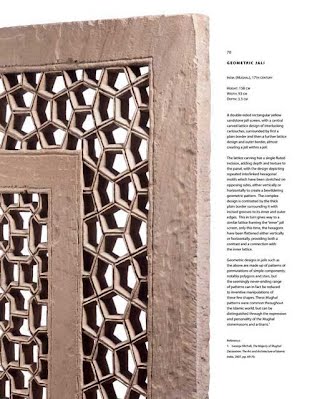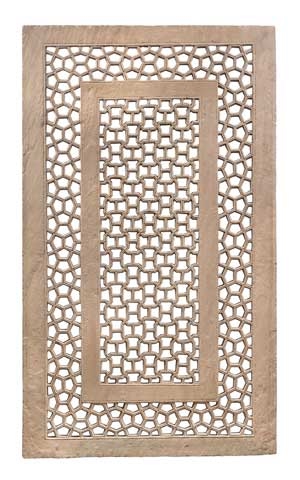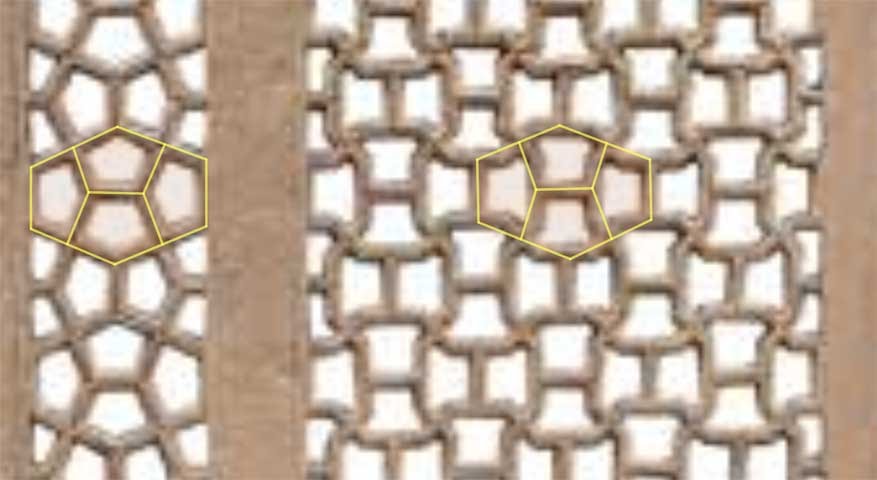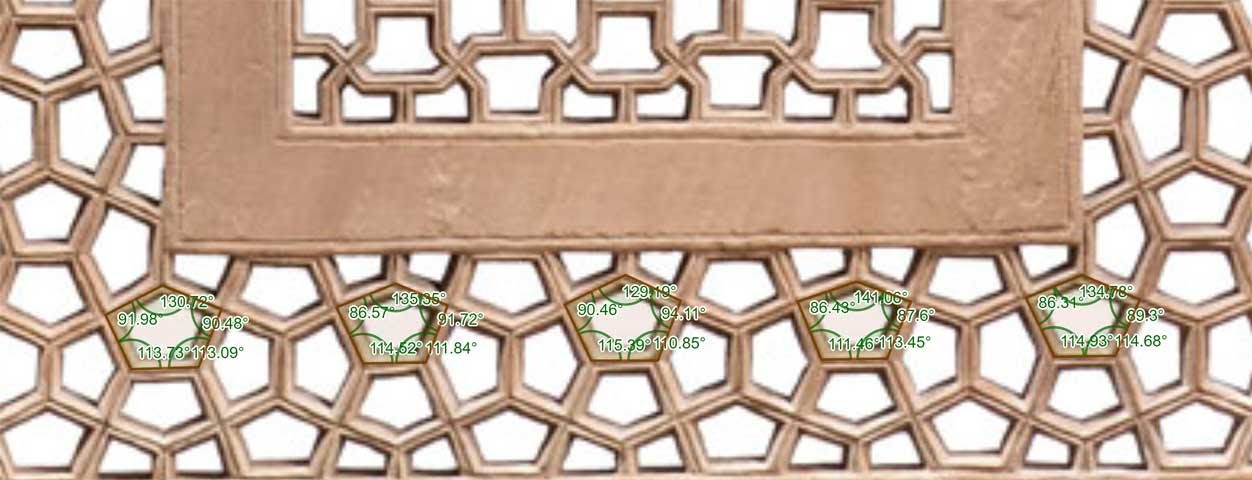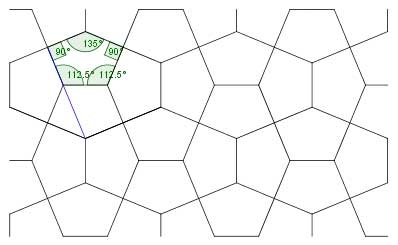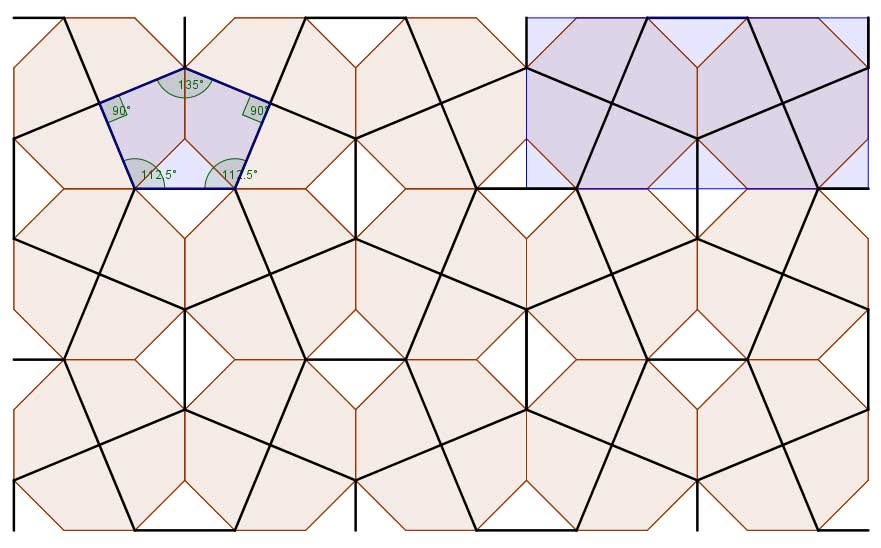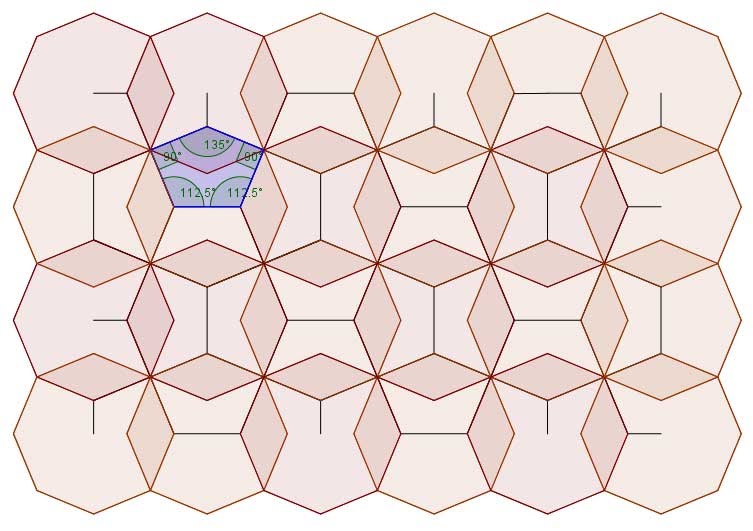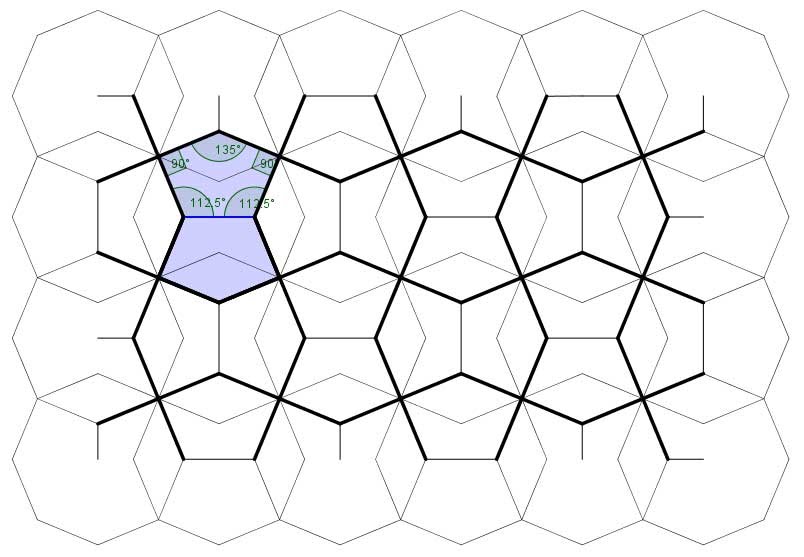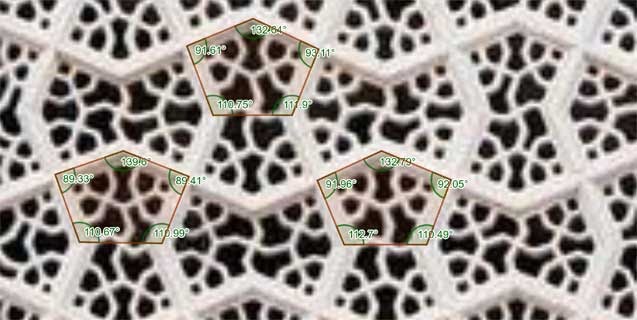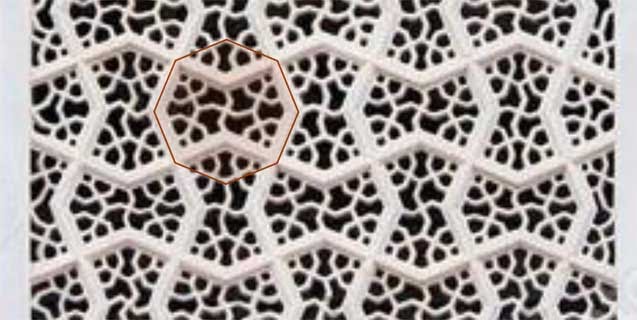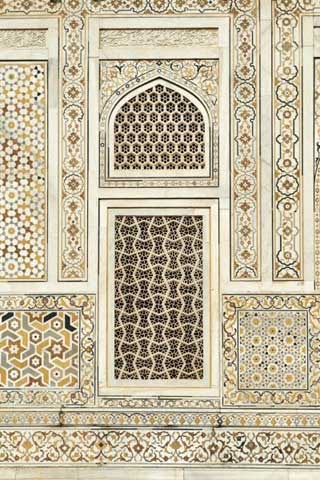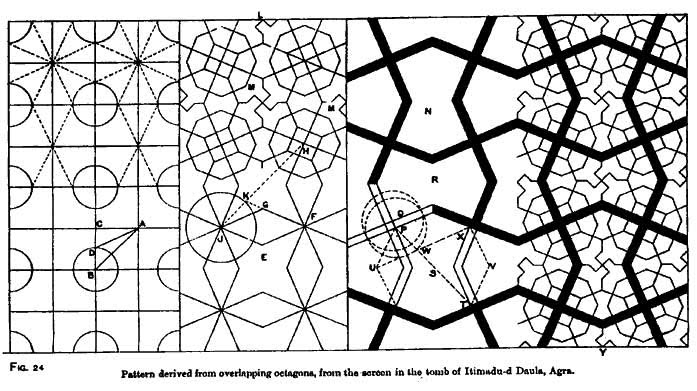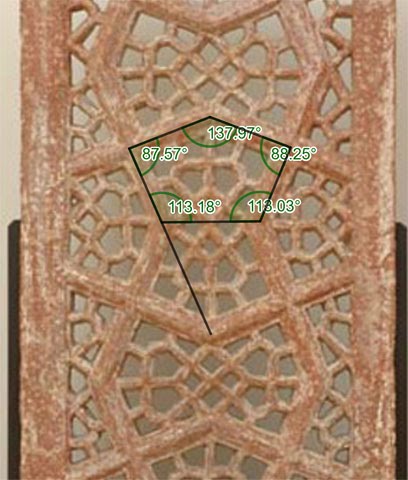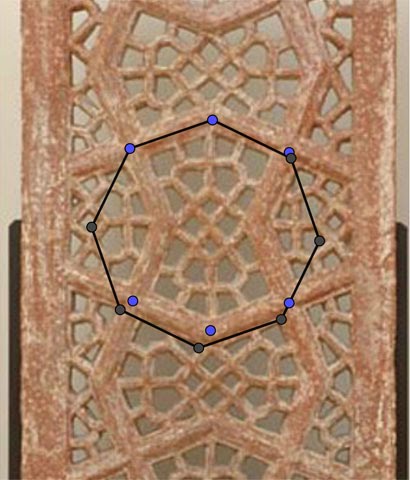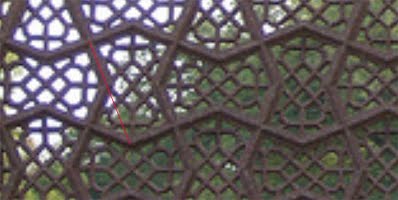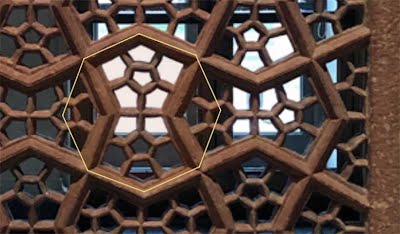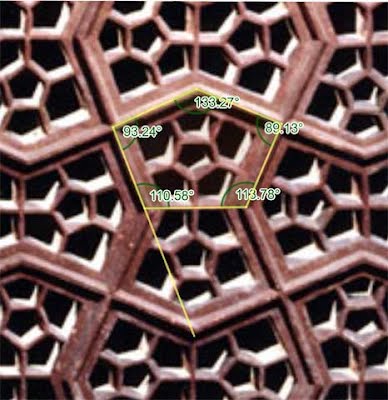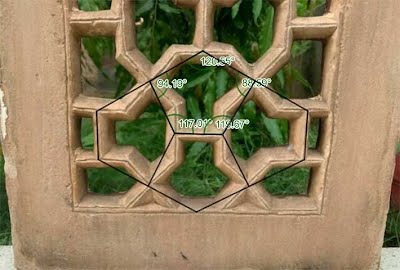UNDER CONSTRUCTION Introduction Of interest is the appearance of the Cairo tiling preceding the in situ instance, of 1957 (although of course not named as such). However, instances, either as artefacts or drawings, are few and far between, and furthermore, with one exception, namely of a 17th-century Mughal jali, as catalogued by Simon Ray, are (perhaps surprisingly) all of the 20th century. Although a generic Cairo tiling is easily drawn, and can be described as an obvious design, it does not appear to show in history. Therefore of particular interest in the Ray jali is the provenance, date, the geometry and possible construction process. Save for the date, none of which is given by himself (and even the date has queries). However, I am a little hamstrung in this task in that my knowledge of jalis and Mughal matters in general pre this specific instance was next to nothing. In short, I had to quickly get up to speed on the subject, and so there may very well be the odd shortcoming, if not the occasional error in such matters here. However, I have indeed striven to be my normal exact self in the study and analysis. To this end, I now examine all these elements in detail as best I can in the circumstances. The Study is in * main parts Part 1. Mughal Jali as Given by Simon Ray, and on Ray Himself (a) A discussion on various aspects of the 17th-century Mughal jali in Simon Ray’s Indian & Islamic Works of Art, of 2016. This includes a transcript of the catalogue entry as well as two pictures (two only are shown in the catalogue). (b) A look at Simon Ray as to the man and background, and see what little extra in the round may be gleaned. (c) Simon Ray contact, or the travails… Part 2. Examination of the Jali (a) Inner and outer parts (b) Angle analysis or, The determination, in principle at least, of the pentagon angles (c) The Construction Speculations as to a definitive pentagon - a Cordovan pentagon? Part 3 Bowtie Jalis PART 1 17th-century Mughal Jali as given by Simon Ray, and on Ray Himself (a) 17th-century Mughal jali in Indian & Islamic Works of Art, of 2016 An outstanding historical instance of the Cairo tiling, to put it mildly, is of what is said to be of a 17th-century Mughal jali¹, or jaali (an Indian perforated stone screen), albeit very little is known as to the background here, as an object in itself and its mathematics. This is pictured and described by Simon Ray, of the UK, a noted dealer in Indian arts (and more), in his catalogue entry in Indian & Islamic Works of Art, of 2016. For the sake of thoroughness I show the entry in full. Italics as in the original: Titled: Geometric Jali, India (Mughal) 17th century. Height: 158cm, Width: 93cm, Depth: 3.3cm (5 ft 2” x 3 ft x 1¼”) Commentary: A double-sided rectangular yellow sandstone jali screen, with a central carved lattice design of interlocking cartouches, surrounded by first a plain border and then a further lattice design and outer border, almost creating a jali within a jali. The lattice carving has a single fluted incision, adding depth and texture to the panel, with the design depicting repeating interlinked hexagonal motifs which have been stretched on opposing sides, either vertically or horizontally, to create a bewildering geometric pattern. The complex design is contrasted by the thick plain border surrounding it with incised grooves to its inner and outer edges. This in turn gives way to a similar lattice framing the “inner” jali screen, only this time the hexagons have been flattened either vertically or horizontally, providing a contrast and a connection with the inner lattice. Geometric designs in jalis such as the above are made up of patterns of permutations of simple components; notably polygons and stars, but the seemingly never-ending range of patterns can in fact be reduced to inventive manipulation of these few shapes. These Mughal patterns were common throughout the Islamic world, but can be distinguished through the expression and personality of the Mughal stonemasons and artisans.¹ References ¹ George Michell. The Majesty of Mughal Decoration. The Art and Architecture of Islamic India, 2007, pp. 69-70 I find the commentary more than a little confused: 1. Of a first reading, it is unclear as to which of the two tilings is being discussed. However (I think!), the first part refers to the Cairo tiling here in so many words, implied from the second discussion. 2. I find the description of cartouches imprecise. To me this is not a cartouche in the normal sense² (but I may be wrong). 3. Oddly, and curiously, no mention is made of tiling, tessellations, or more specifically of pentagons in the text, although there is to the subsidiary hexagons! Tiling seems to be implied by ‘pattern’ here. 4. Peripheral to the Cairo tiling, the inner (octagon) tiling is discussed in terms of hexagons, which is a little strange, as although an underlying grid of (par)hexagons can be discerned, this is not obvious. As I show below, this is related to the jali Cairo tiling. I can only conclude here that the commentary, seemingly written by Leng Tan (see the acknowledgements in the catalogue), Ray’s associate, is not well versed in mathematics. 5. The broad mathematical discussion in general at the end is vague and imprecise. 6. A reference to a book by the authority Asian architecture expert George Michell, which at first sight leads to this particular jali, is misleading. I obtained the book, but this jali was not there. Rather, the reference was generic to jalis and not specific, as hoped for. Fig. 1, (a) and (b). Pages from the catalogue (b) Simon Ray - Islamic and Indian Art Dealer Ray is one of London's leading fine art and Islamic and Indian Art dealers, and so weight should indeed be put upon this entry as to veracity in all senses. However, it is as well to reexamine. I begin by examining the date. From the sparse detail to hand, the 17th century gives us from 1601–1700, whilst the Mughal era was of 1526–1540 and 1555–1857, the latter of which offers no extra clue. Therefore the date is given to within a hundred years. It is not clear as to how the date is attributed. Is this knowledge of his field or documentation? Early jali work was built by carving into stone, generally in geometric patterns, while later the Mughals used very finely carved plant-based designs, as at the Taj Mahal. Possibly the date is based on this. Another clue is possibly afforded by the colour of the sandstone, yellow. Red sandstone in general appears the more popular. However, I have been unable to establish if there is any significance as to periods here. Interestingly, and curiously, the other entries are much more detailed, which suggests that there is little more known than what is already given. Jalis, in all forms, of history, and its intricacies, are not my field, although I have of course read up on this a little, and so I bow to Ray’s greater knowledge here. As such, from reading up on Ray’s interest in Islamic Art, of which he is an authority, and given he is head of such a noteworthy company, I will accept the date given as true, albeit with due reservation. Of interest is that this is the only known jali of the Mughal period with a Cairo tiling. No mention is made of the Cairo tiling on the pages, unsurprisingly, and so whether the Cairo tiling is known to Ray is unknown. However, without any obvious mathematical background or interest, it is unlikely that Ray would be familiar with this association. So far as I am aware of, this is the only appearance of this jali in print. More modern-day Cairo tiling jalis (21st century) can occasionally be seen. (c) Enquiring with Simon Ray on the Jali Of some not inconsiderable interest is of the age and provenance of the jali. Although 17th-century is given, this is not documented, and notably, and regrettably, the provenance is not stated. Naturally, on account of the great age here, of which if so is the earliest extant instance of a Cairo tiling by far, of no less than three to four hundred years, predating that next confirmed reference of the early 1900s (not a jali), and so is thus historically an artefact of the utmost significance. Therefore, I thus attempted to contact Ray to find more detail on this. However, despite his email address being freely available (and so appearing to welcome queries), this was to no avail. Despite an obvious bona fide query in his field, two emails from myself went unanswered. As detailed above, given the historical aspect, I was loathed to give up on this, and then at my behest two others from interested parties of the Cairo tiling from academia also wrote to him, namely professors Gregg De Young (American University in Cairo) and Chaim Goodman-Strauss (University of Arkansas), stressing their academic credentials, but they still met with no reply! In the midst of this, I then tried other ways. I also contacted his associate Leng Tan, who apparently wrote the captions, but he too did not respond. Another was George Michell, of whom the book he quotes in the references, but who also did not reply (although as he was not directly involved with this jali, I do not unduly castigate him here, in contrast to others). I also phoned Ray’s office, and although Ray was unavailable, I spoke to one of his assistants who reliably informed me that the details in the catalogue would be true. However, without any provenance, this remains far from satisfactorily resolving matters. It really is infuriating! Even if not of a detailed reply, just a few words as to provenance would surely not be asking too much of a genuine enquiry in their field? Perhaps we all are simply too small fry to bother with; from what I can make out, his company turns over millions of pounds a year. But for whatever reason, Ray and his associates choose not to answer. Come on, Simon, in the unlikely event of you reading this, redeem yourself here! All will be forgiven! Further, I also enquired with this as to the noted native authority El Nath, who, in addition to his website, has recently published (2018) a book on Mughal Jalis. However, he seemed to misunderstand my specific request, and so I did not pursue the matter. Ideally, I would have investigated the book, but as it is a little expensive, and from seeing what is likely the material on his website placed in a book, I decided not to pursue it. PART 2 Jali Analysis - Inner and Outer Parts (a) Jali - The Two Tilings The jali is interesting in itself as a ‘jali within a jali’, of in effect another, different tiling. So far as I can establish, this is the only instance known (I here disregard some ‘mini-subsection’ instances, divided into rectangles). However, despite the jali seemingly consisting at first sight of two unrelated tilings, of pentagons and octagons, these can be seen to be related, as first pointed out in correspondence in January 2019 by the geometer George Baloglou. In short, it is possible to overlay a Cairo tiling onto suitable octagon tile vertices (Fig. 2). Furthermore, it can be seen that the subsidiary hexagons from any one tiling match the other. Therefore, each tiling can be transposed from one to the other. Aesthetically, this is most pleasing indeed, and reflects well on the (unfortunately anonymous) designer! This can hardly have been accidental; it must have been purposeful. Indeed, he has gone up even further in my estimation! (b) In Situ Angle Analysis or The Determination, in principle at least, of the pentagon angles Of obvious interest is the determination of the angles of the pentagons, of which this is perhaps, not unsurprisingly, unaddressed in the Ray catalogue. However, as I discuss below, the matter is not easily resolvable for a variety of reasons. First, I am unable to measure the angles in situ. Second, of necessity, I have to rely on an image, which is on the face of it not ideal, in that in such circumstances the picture is typically shown at an angle, which is hopeless for determining such exact and demanding angle matters. However, the matter is aided in that one of the pictures I have to hand is just about as ideal as it will get, face on, without any perceivable distortion! However, measuring the angles is still not easy as it may otherwise appear to be! There are problems in outlining the defining pentagon. A problem arises in defining the vertices due to the nature of the jali, of chiselled, grooved lines, along with the inadvertent minor imperfections of the artisan. Defining an exact spot to place a vertex is difficult. For instance, see the second pentagon, lower. This is noticeably distorted by the carver. However, there are indeed ‘indications’, where lines cross and meet, and in my assessment it is possible to be accurate to a reasonable assessment, but not to the nearest degree with any amount of confidence, at least of a single arbitrary measure. One drawback is that the image is relatively small and so susceptible to error measurement. In short, to measure this by hand with a traditional protractor is problematic; it is far too crude a means. By far the best solution is to import the image into a dynamic geometry software, such as GeoGebra (my favoured software), which will permit enlargement (albeit here with the loss of resolution). When so enlarged, great accuracy can be assumed. Further interactive adjustment is possible, if so desired, and so measurement with much greater accuracy than by hand is possible. Note that the following figures should be borne with the above in mind; true right angles were not always possible. The slightest alteration of a vertice can result in movements of many degrees. To this end, I outlined ten pentagons, this judged a sufficient number to sample to give a broad indication, and measured the angles directly on the jali, and listed as tables, below, Fig. 3. Fig. 3 (a) Top part of the Jali, with angle analysis Fig. 3 (b) Lower part of the Jali angle with angle analysis Data as a table, Top, rounded up and down to the nearest degree Average: 111.4, 137.2, 112.4 Average: 114, 134.2, 112.8 To say the least, there are considerable vagaries here, of all the two variable angles, much more so than I was expecting. Even when the 90° angle is known, this does not always show as 90°. For any one set of data, to determine the angles here, to a degree, is simply impossible; only a rough indication is possible. However, when the above angles are averaged to the nearest degree (mean, excluding the known 90°) this gives a typical pentagon of (top section) 111.4, 137.2, 112.4 and (lower section) 114, 134.2, 112.8. An immediate observation is that this is very close to the aesthetic and special ‘Cordovan Pentagon’, so named and popularised by Redondo and Reyes, following in the footsteps of the Spanish architect la Hoz, of the variable angles of 112.5° and 135°. Fig. 4(a). However, with such vagaries, this is not necessarily convincing. A distinct possibility, yes, but not definite. What is needed is a more compelling measure. A convenient feature of this particular pentagon is that when it has a side extended, it can be seen to alight on a vertex (Fig. 4(b), which is a rare feature of a generic Cairo tiling (there is one other possibility). Jali - In Situ Analysing by Extending a Side Length To this end, I now suitably extend the side on the jali. As can be seen, it clearly, within the limitations of the image, alights on a vertex (Fig. 5). Again, I use more than one instance; five, as a 'fair sample'. Fig. 5. Extending sides to alight on a vertex. From this it would indeed appear to alight on a vertex, and so a reasonable supposition is that this is indeed a Cordovan Pentagon! If it is indeed the Cordovan pentagon it would be very pleasing, and of which opens up further questions as to why this specific Cairo pentagon, and not other pentagons. As I show on my ‘Minima to Maxima’ page, there is a range of generic 'incremental angle' Cairo tilings, from minima with a rectangle, to maxima, with a square. However, only a few can be seen to have special properties, as likely exemplified by the above instance. Further, it can be seen to be exactly mid-range of the 91 pentagons in that listing, and so it can be described as the most average of all. Below I show an condensed listing from that page, showing the mid-range aspect. * LB, SS = Long Base, Short Sides; SB, LS = Short Base, Long Sides (c) The Construction Therefore, all the indications are that the pentagon was specially chosen/devised, as against a generic instance. However, this is not necessarily so! As I show below, the Cordovan tiling is easily drawn by one of two methods, involving octagons. I now believe that the tiling thus arose by default, without any considerations as to the alighting feature. In short, this feature is a 'happy accident'. However, the question then arises to how this was drawn. Such specific angles of a single pentagon and then suitably repeated three times to form a unit hexagonal repeating cell are not readily drawn by the tools of the day, or indeed even now by a traditional compass. However, as alluded to by the Cordovan proportion, with its underlying octagon premise, this can be seen in the pentagon here. More than likely, it was devised by a regular octagon, in one of two ways: Fig. 6(a) by a semiregular tiling 4.8.8. (square and regular octagon tiling) or Fig. 6(b) overlapping octagons suitably arranged. Whatever the method, both require an additional intervention for the baseline. Both methods are relatively simple, and one of these I consider must have been used. However, I consider the overlapping octagons by far the more obvious choice, on the grounds of simplicity. Fig. 6(b) Overlapping octagons underlying framework. This can be described as 'Hankin Method 2'; see below. Interestingly, to give further support to my hypothesis, octagons can be seen to be used in other jalis, as I discuss in depth in Part 3. Further, Emil Makovicky and N. M Makovicky in a paper discuss octagons in Mughal jalis, as does E. H. Hankin. Further, overlapping octagons can be seen at the Taj Mahal. Admittedly, all this is unrelated to the pentagon here, but this shows that octagons were very much in the mind of Mughal designers, and so is a more than plausible construction than this one-off instance of mine shows. PART 3 'Bowtie' Jalis Of interest in generic Cairo tiling matters to the study here is that of a related tiling, namely of a ‘bowtie’. I show a generic instance as a line drawing (Fig. *). This can be interpreted in two ways: (a) as a fused Cairo tiling, where the baseline is omitted, or (b) as an octagonal tiling in its own right, formed by zigzag lines. Such bowties are commonly seen in Mughal architecture, invariably with an inner, secondary tiling. In short, in all instances the bowtie is emphasised, whilst the inner is plainly subsidiary, and so although strictly this is a multifaceted tiling, as the bowtie is clearly differentiated, I thus regard it as so in intent. As with the Cairo tiling, the bowtie can form a range of angles, degenerating to squares and rectangles. Of interest therefore is the angles used in these instances, and seeing in particular if these are so formed as according to the octagon procedure as outlined above. In short, a Cairo tiling can be so formed from a bowtie by the suitable addition of a line joining the 'waist' of the tile, and is an obvious 'next step'. These sightings include: 1. Tomb of I'timād-ud-Daulah in Agra, India, 1622–1628 (possibly octagons) 2. Marble Window Screen (Jali), ca. 17th century, Mughal India. The Metropolitan Museum of Art, New York, USA (not octagons) 3. Louvre Museum, Paris, France. 16th-17th century (possibly octagons) 4. Tomb of Akbar in Sikandra, Agra, India, 1605–1613 (possibly octagons) 5. Toledo Museum of Art, Ohio, USA. 'Zigzag Jali, India, Mughal, Jahangir period, 1605-1627' (possibly octagons) 6. Musée departemental des Arts Asiatiques, NIce, France, 'North India Beginning of 17th century (circa 1610) Mughal Empire. Pink sandstone' (possibly octagons) An obvious investigation is to see whether these are indeed based on regular octagons, as analysed below. Fig. x. Deriving a bowtie tiling from a Cordovan Pentagon with overlapping octagons Brief background detail (from Wikipedia) Tomb of I'timād-ud-Daulah (I'timād-ud-Daulah Maqbara) is a Mughal mausoleum in the city of Agra in the Indian state of Uttar Pradesh. Often described as a "jewel box", sometimes called the "Bachcha Taj", the tomb of I'timād-ud-Daulah is often regarded as a draft of the Taj Mahal. Along with the main building, the structure consists of numerous outbuildings and gardens. The tomb, built between 1622 and 1628, represents a transition between the first phase of monumental Mughal architecture – primarily built from red sandstone with marble decorations, as in Humayun's Tomb in Delhi and Akbar's tomb in Sikandra – to its second phase, based on white marble and pietra dura inlay, most elegantly realized in the Taj Mahal. Fig. x. Enlarged and detail jali from the tomb of I'timād-ud-Daulah in Agra. Possibly a Cordovan pentagon Fig. x. Enlarged and detail jali from the tomb of I'timād-ud-Daulah in Agra with octagon overlay Fig. x. I'timād-ud-Daulah jali sighting in context Fig. x. Hankin analysis of the tomb of I'timād-ud-Daulah in Agra 2. Metropolitan Museum of Art Described as Title: Pierced Window Screen (Jali) Date: early 17th century Geography: Attributed to India Medium: Marble Dimensions: H. 48 7/16 in. (123 cm) W. 26 1/2 in. (67.3 cm) D. 2 3/4 in. (7 cm) Wt. 213 lbs. (96.6 kg) More background detail is at: 3. Louvre Museum, Paris, France Fig. x. Enlarged and detailed jali in the collection of the Louvre Museum, Paris, France. A case is made for a plausible Cordovan pentagon, as according to close angles (112.5 and 135), and the alighting of a extended side length on a vertex. However, as a possible counter to this conjecture, see the following two diagrams, of which the specific pentagon is far less certain. Fig. x. Enlarged and detailed jali in the collection of the Louvre Museum, Paris, France with regular octagon overlay, left, and upon 'free placed' vertices. The correlation of a Cordovan pentagon is far from ideal. Described as: Unknown (India, Mughal) / Pierced Window Screen (Jali), / late 16th - early 17th century / red sandstone / 39 3/4 x 24 x 5 in. (101 x 61 x 12.7 cm) / Private collection / / The surface pattern of this jali is extremely close in design to the pierced window screens that enclose the courtyard of the Great Mosque (ca. 1571) at Fatehpur Sikri, the erstwhile Mughal capital. 4. Akbar's tomb in Sikandra, a suburb of Agra, Uttar Pradesh, India Brief background (from Wikipedia): Akbar's tomb is the tomb of the Mughal emperor Akbar. This tomb is an important Mughal architectural masterpiece. It was built in 1605–1613 by his son Jahangir and is situated in 119 acres of grounds in Sikandra, a sub of Agra, Uttar Pradesh, India. Fig. x. Enlarged and detailed jali at Akbar's tomb in Sikandra: (a) superimposed regular octagon (b) side extended alighting on a vertex Fig. x. Hankin analysis of the tomb of Akbar in Sikranda. As can be seen, he shows a underlying 4.8.8 tiling, suitably adapted with additional lines, as with my Fig. 8(a). A case is made for a plausible Cordovan pentagon, as according to the superimposed regular octagon, and the alighting of an extended side length on a vertex. However, the superimposition is not as exact as I would like, and so doubts remain. 5. Toledo Museum of Art, Ohio, USA An interesting, although seemingly little known jali, as I have only seen one reference to this, is at the Toledo Museum of Art, Ohio, USA. However, details are scant indeed. This is described on the ‘Collective Arts Network (CAN) site’ as: Zigzag Jali, India, Mughal, Jahangir period, 1605-1627. Unfortunately, the museum text on the exhibit description was not discernible. The provenance and dimensions are not known. Looking on the Toledo Museum website I could not find this. Fig. x. Enlarged and detailed jali at Toledo Museum. (a) overlayed with pentagon and angles, and side extended to a possible vertex (b) overlayed with regular octagon
Again, a case is made for a plausible Cordovan pentagon, as according to the superimposed octagon, and the alighting of an extended side length on a vertex. However, I am far from certain; another analysis, not shown, was not so convincing. Also see the next entry, from the Musée departemental des Arts Asiatiques, France, for a same secondary interior decoration. I was first alerted to this (jali) by the work of Andrew Theis, an American Cairo tiling enthusiast, who has used it in much of his stenciling work, in which he repeated the jali, including the interior decoration. He stated on his Tumblr page: ...I first saw this pattern at my hometown [Toledo] art museum from a 16th century stone screen… Upon following this up with him he told me (on a Tumblr posting, 8 October 2015): ...I’ve scoured my notes and can’t find the specific piece in pictures on the museum’s site or my sketchbooks; it’s been many years since I first saw it. From memory, I am unsure if I then saw it at that time. I think so, but not for certain. I did not seemingly realise the significance. Latterly, in a posting by Brittany M. Hudak, an independent curator and arts writer based in Cleveland, Ohio, essentially as an appendage to an exhibit¹ by Anila Quayyum Aghathe CAN site of 2019?, stated, and showed a picture: In fact, having spent an inordinate amount of time in the Toledo Museum of Art, I immediately thought of one of their recent acquisitions – on view all the way at the other end of the building, this Zigzag Jali (Screen), from Mughal India. Whatever the dates, this seems to be a relatively recent acquisition. ¹ Exhibit by Pakistani-American artist Anila Quayyum Agha tilted ‘Between Light and Shadow’ at the Toledo Museum, Oct. 19, 2019 — Feb. 9, 2020. http://canjournal.org/2019/11/between-light-and-shadow-at-the-toledo-museum-of-art/ 6. Musée departemental des Arts Asiatiques, Nice, France An interesting, although seemingly little known jali, as I have only seen one reference to this, is at the Musée departemental des Arts Asiatiques, Nice, France. However, details are scant indeed. This is described on their site as: The Mughal king Jahangir appreciated precise, simple and refined geometric decorations. This jali, composed of zigzag patterns, was intended to filter the light from the sun as well as from the lanterns that lit the palace at night. Captioned: North India Beginning of 17th century (circa 1610) Mughal Empire. Pink sandstone I only have one picture of this jali, and of which it is not ideal, in that it is not face on; close, yes, but slightly angled. Therefore, more than most here, I am wary of being dogmatic in my analysis. In places, what appeas to be a clear line is a shadow. However, a broad Cordovan pentagon can be discerned, although other analyses, not shown, are not so sure, and are far less certain. At best, this is a rough indication. Also see the above entry, from the Toledo Museum, US, for a same secondary interior decoration. Fig. x Enlarged and detailed Jali at Musée departemental des Arts Asiatiques. (a) overlayed with pentagon and angles, and side extended to a possible vertex (b) overlayed with regular octagon Inner part variation of the Ray Jali Note that the related ‘inner’ tiling can also be seen separately as a variation as another jali in its own right, stated as Mughal, found on eBay. However, details are scant indeed. All the detail given is a basic description, without provenance: Ancient Rare Hand Carved Mughal Two Color Stone Jharokha Jali Cut Wall Window, £686.09 The analysis shows that this is possibly based on a 120°, 90° 120°, 90° 120° pentagon. Fig. x. Inner part variation of the Ray JaliDeceptive Cairo Tile Appearance in Mughal Architecture On occasions, another what appears to be Cairo tiling can be seen in Mughal architecture, but this is more properly of the fish scale clam shell tiling (both descriptions are used). Typically, as seen from afar, this is easily mistaken, or at least at first sight. A typical instance is at the Fatehpur Sikri, famed for its central pillar, of red sandstone. From a distance, I defy anyone to be definitive, especially when one is purposefully looking for pentagons, and so is subconsciously biased. [PICTURE] Fig. x. Fatehpur Sikri interior, from afar Conclusion As such, I consider the finding here of a precursor to the Cordovan pentagon, highly significant, if indeed this is so as determined by my analysis above, as well as the presumed accuracy of the dating of the jali by Ray. This is the first Cairo-like tiling known, by no less than three-four hundred years! The designer must surely have been aware of at least some of its special attributes. Therefore, in his honour, in recognition of his heritage, I am now proposing to call this the ‘Mughal Pentagon’. Comments as to my many suppositions are welcomed, as is any speculation to the study in the round, of whatever aspect. Open questions abound: 1. How did, and by what means, did it get to London? This is a substantial heavy artefact, probably weighing hundreds of pounds! 2. What has become of the jali? Presumably, it has been sold, as it does not appear in later years of his catalogue, up to and including the present day (2019; the 2020 catalogue has yet to be made available). I have not seen any other references to this jali elsewhere. 3. The designer. Were there many jali designers, or just a few? Are any names known? Was there a ‘pattern book’ of the day? 4. Does the pentagon design (and the designs in general of jails) have a name? Notes 1. An Indian perforated stone screen, which helps in lowering the temperature by compressing the air through the holes. 2. George Michell is a world authority on South Asian architecture. 3. An ornate frame around a design or inscription. (Encyclopaedia Britannica)References Abbas, Masooma. ‘Ornamental Jālīs of the Mughals and Their Precursors’. International Journal of Humanities and Social Science Vol. 6, No. 3; March 2016. A good general guide to jalis. http://www.ijhssnet.com/journals/Vol_6_No_3_March_2016/16.pdf Bailey, David. ‘Minima to Maxima’. (Webpage) A listing of the all possible pentagons, in ½° incremental angles, where the tiling degenerates to a square and rectangle (the latter in a basketweave configuration). http://www.tess-elation.co.uk/cairo-tiling/minima-to-maxima Gil-López, Tomás. 'The Vault of the Chapel of the Presentation in Burgos Cathedral: “Divine Canon? No, Cordovan Proportion”', April 2012, Nexus Network Journal 14(1) Of general Cordoba interest, but is notably without any pentagon discussion. https://www.researchgate.net/publication/257314781_The_Vault_of_the_Chapel_of_the_Presentation_in_Burgos_Cathedral_Divine_Canon_No_Cordovan_Proportion/link/580c637608aeef1bfeeb62c0/download Huylebrouck, Dirk, A. Redondo, and E. Reyes. ‘Octagonal Geometry of the Cimborio in Burgos Cathedral’. Nexus Network Journal 13, (2011) 195–203 Of general Cordoba interest, but is notably without any pentagon discussion. https://www.researchgate.net/publication/225784187_Octagonal_Geometry_of_the_Cimborio_in_Burgos_Cathedral Hoz Arderius, R. La proporción Cordobesa. Actas de la quinta asamblea de instituciones de Cultura de las Diputaciones. Ed. Diputación de Córdoba (1973). NOT SEEN Translated: The Cordovan proportion. Minutes of the fifth assembly of Culture institutions of the Provincial Councils. Hoz Arderius R. Rafael de la Hoz. Consejo Superior de los Colegios de Arquitectos de España. Córdoba (Spain) (2005). NOT SEEN Translated: Superior Council of the Colleges of Architects of Spain. Makovicky, E. and N. M. Makovicky. ‘Nonperiodic Octagonal Patterns from a Jali Screen in the Mausoleum of Muhammad Ghaus in Gwalior and Their Periodic Relatives’. Nexus Network Journal 19(1):1-20 November 2016 A general discussion on octagons in Mughal jalis; the possible connection to my hypothesis is not addressed. Michell, George. The Majesty of Mughal Decoration. The Art and Architecture of Islamic India. Thames & Hudson, 2007. Quoted in Ray’s Islamic catalogue of 2016. Nath, R. Mughal Jali Art: Perforated Stone Screens & Railings in Mughal Architecture. The Heritage Ajmer/Jaipur/ INDIA. First edition 2018. NOT SEEN Ray, Simon. Indian & Islamic Works of Art. Self Published Catalogue, 2016, pp. 178-179. https://www.simonray.com/catalogue_2016.htm (The entire catalogue) Redondo, A. and Reyes, E. (2008a). ‘The Cordovan Proportion: Geometry, Art and Paper folding’. In: Proceedings of 7th Interdisciplinary Conference ISAMA 2008-Valencia, Spain. Hyperseeing, May-June, 107-114 (2008). ‘Cordovan pentagon’ i.e. a Cairo tiling is given here for the first time. The same research is basically repeated, with seemingly minor variations, in three other publications by the authors. Redondo, A. and Reyes, E. (2008b). ‘The Geometry of the Cordovan Polygons’, Visual Mathematics, 10, No 4 www.mi.sanu.ac.yu/vismath/redondo2009/cordovan.pdf Redondo, A. and Reyes, E. (2009). ‘Cordovan Geometrical Patterns and designs’. Symmetry: Art and Science, 009/1-4. Special Issue for the Conference of ISIS-Symmetry. Symmetry of Forms and Structures, Wroclaw-Cracow, Poland, 68-71, (2009). Redondo, A. and Reyes, E. ‘Geometry and Art from the Cordovan Proportion’. In ‘Mathematics and modern art’. Proceedings of the first ESMA (European Society for Mathematics and the Arts) conference, Paris, France, July 19–22, 2010 https://www.researchgate.net/publication/268271057_Geometry_and_Art_from_the_Cordovan_Proportion Reyes, Encarnación and Inmaculada Fernández. Pentágonos. Construcciones. Mosaicos, Geometría sagrada. (in Spanish) 2015. Universidad de Valladolid Translated: Pentagons. Buildings. Mosaics, Sacred Geometry P. 156 Varanashi, Satyaprakash. ‘The multi-functional jaali’. The Hindu. January 30, 2011 Of general interest, on the decline of jalis. Page Created 10 August 2020. Continued ad hoc 11-14, 17-20, 24-28 August as 'Release 1', of 28 August 2020. |
Cairo Tiling >
